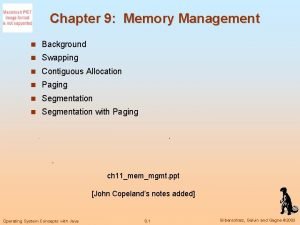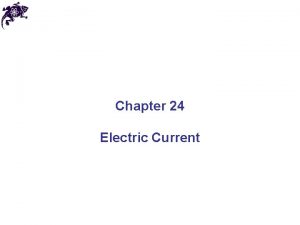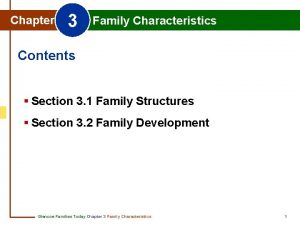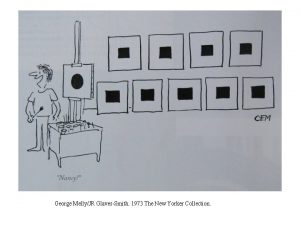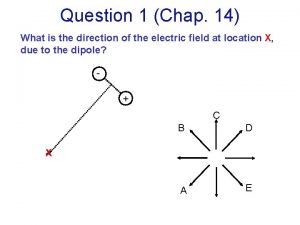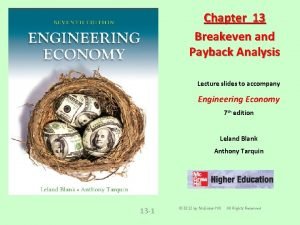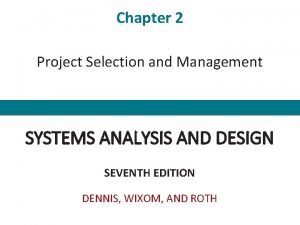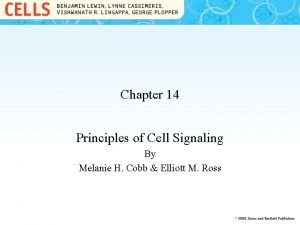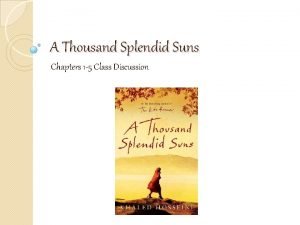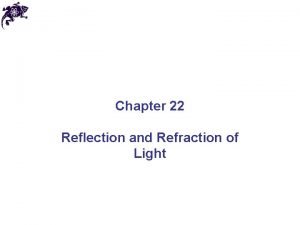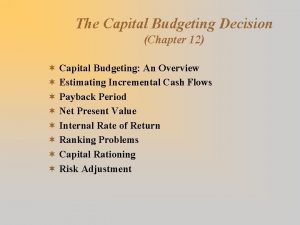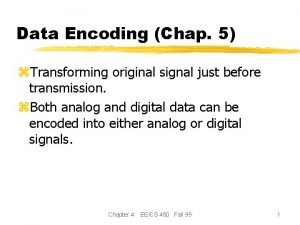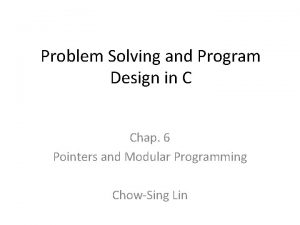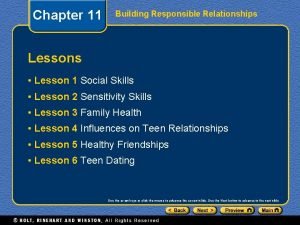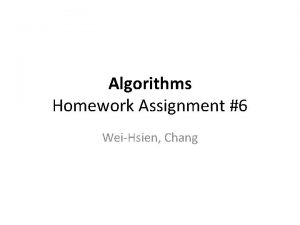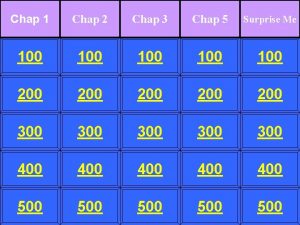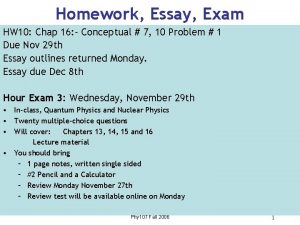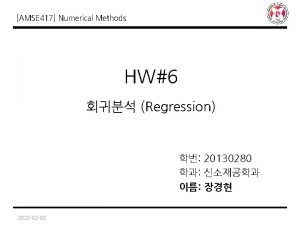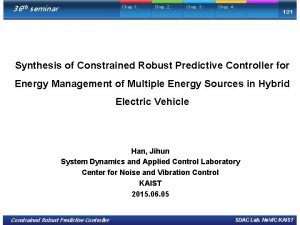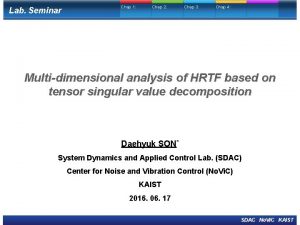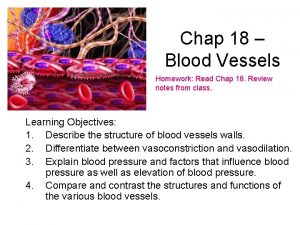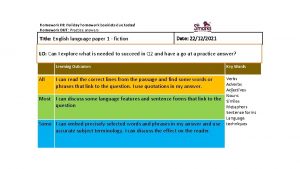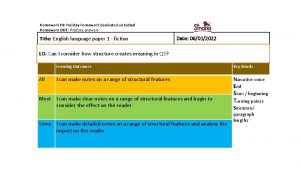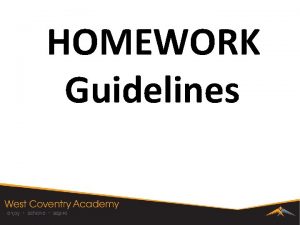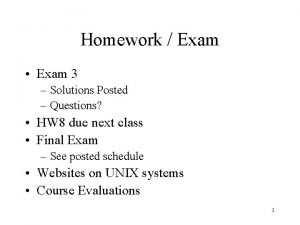Homework Exam HW6 Chap 10 Chap 11 Conceptual









































- Slides: 41

Homework - Exam HW#6: Chap 10 Chap 11 Conceptual: 36, 42 Problem 7, 9 Conceptual: 5, 10 Hour Exam 2: Wednesday, October 25 th • In-class, covering waves, electromagnetism, and relativity • Twenty multiple-choice questions • Will cover: Chapters 8, 9 10 and 11 Lecture material • You should bring – 1 page notes, written single sided – #2 Pencil and a Calculator – Review Monday October 23 rd – Review test online on Monday Phy 107 Fall 2006 1

From last time… • Einstein’s Relativity – All laws of physics identical in inertial ref. frames – Speed of light=c in all inertial ref. frames • Consequences – Simultaneity: events simultaneous in one frame will not be simultaneous in another. – Time dilation – Length contraction – Relativistic invariant: x 2 -c 2 t 2 is ‘universal’ in that it is measured to be the same for all observers Phy 107 Fall 2006 2

Review: Time Dilation and Length Contraction Time in other frame Time in object’s rest frame Times measured in other frames are longer (time dilation) Length in other frame Length in object’s rest frame Distances measured in other frames are shorter (length contraction) • Need to define the rest frame and the “other” frame which is moving with respect to the rest frame Phy 107 Fall 2006 3

Relativistic Addition of Velocities • As motorcycle velocity approaches c, vab also gets closer and closer to c • End result: nothing exceeds the speed of light vdb Frame b vad Frame d Object a Phy 107 Fall 2006 4

Observing from a new frame • In relativity these events will look different in reference frame moving at some velocity • The new reference frame can be represented as same events along different coordinate axes ct’ New frame moving relative to original ct Coordinates in new frame x’ Coordinates in original frame Phy 107 Fall 2006 x 5

A relativistic invariant quantity Earth Frame Ship Frame Event separation = 4. 3 LY Event separation = 0 LY Time interval = 4. 526 yrs Time interval = 1. 413 yrs • The quantity (separation)2 -c 2(time interval)2 is the same for all observers • It mixes the space and time coordinates Phy 107 Fall 2006 6

‘Separation’ between events • Views of the same cube from two different angles. • Distance between corners (length of red line drawn on the flat page) seems to be different depending on how we look at it. • But clearly this is just because we are not considering the full three-dimensional distance between the points. • The 3 D distance does not change with viewpoint. Phy 107 Fall 2006 7

Newton again • Fundamental relations of Newtonian physics – – – acceleration = (change in velocity)/(change in time) acceleration = Force / mass Work = Force x distance Kinetic Energy = (1/2) (mass) x (velocity)2 Change in Kinetic Energy = net work done • Newton predicts that a constant force gives – Constant acceleration – Velocity proportional to time – Kinetic energy proportional to (velocity)2 Phy 107 Fall 2006 8

Forces, Work, and Energy in Relativity What about Newton’s laws? • Relativity dramatically altered our perspective of space and time – But clearly objects still move, spaceships are accelerated by thrust, work is done, energy is converted. • How do these things work in relativity? Phy 107 Fall 2006 9

Applying a constant force • Particle initially at rest, then subject to a constant force starting at t=0, momentum = (Force) x (time) • Using momentum = (mass) x (velocity), Velocity increases without bound as time increases Relativity says no. The effect of the force gets smaller and smaller as velocity approaches speed of light Phy 107 Fall 2006 10

Relativistic speed of particle subject to constant force Newton • At small velocities (short times) the motion is described by Newtonian physics Einstein • At higher velocities, big deviations! • The velocity never exceeds the speed of light Phy 107 Fall 2006 11

Momentum in Relativity • The relationship between momentum and force is very simple and fundamental Momentum is constant for zero force and This relationship is preserved in relativity Phy 107 Fall 2006 12

Relativistic momentum • Relativity concludes that the Newtonian definition of momentum (p. Newton=mv=mass x velocity) is accurate at low velocities, but not at high velocities Relativistic gamma The relativistic momentum is: mass velocity Phy 107 Fall 2006 13

Was Newton wrong? • Relativity requires a different concept of momentum • But not really so different! • For small velocities << light speed 1, and so prelativistic mv • This is Newton’s momentum • Differences only occur at velocities that are a substantial fraction of the speed of light Phy 107 Fall 2006 14

Relativistic Momentum • Momentum can be increased arbitrarily, but velocity never exceeds c • We still use Newton’s momentum • For constant force we still have momentum = Force x time, but the velocity never exceeds c • Momentum has been redefined Relativistic momentum for different speeds. Phy 107 Fall 2006 15

How can we understand this? • acceleration much smaller at high speeds than at low speeds • Newton said force and acceleration related by mass. • We could say that mass increases as speed increases. • Can write this — mo is the rest mass. — relativistic mass m depends on velocity Phy 107 Fall 2006 16

Relativistic mass • The the particle becomes extremely massive as speed increases ( m= mo ) • The relativistic momentum has new form ( p= mov ) • Useful way of thinking of things remembering the concept of inertia Phy 107 Fall 2006 17

Example • An object moving at half the speed of light relative to a particular observer has a rest mass of 1 kg. What is it’s mass measured by the observer? So measured mass is 1. 15 kg Phy 107 Fall 2006 18

Question A object of rest mass of 1 kg is moving at 99. 5% of the speed of light. What is it’s measured mass? A. 10 kg B. 1. 5 kg C. 0. 1 kg Phy 107 Fall 2006 19

Relativistic Kinetic Energy • Might expect this to change in relativity. • Can do the same analysis as we did with Newtonian motion to find • Doesn’t seem to resemble Newton’s result at all • However for small velocities, it does reduce to the Newtonian form Phy 107 Fall 2006 20

Relativistic Kinetic Energy • Can see this graphically as with the other relativistic quantities • Kinetic energy gets arbitrarily large as speed approaches speed of light • Is the same as Newtonian kinetic energy for small speeds. Phy 107 Fall 2006 Relativistic Newton 21

Total Relativistic Energy • The relativistic kinetic energy is Depends on velocity Constant, independent of velocity • Write this as Total energy Kinetic energy Phy 107 Fall 2006 Rest energy 22

Mass-energy equivalence • This results in Einstein’s famous relation • This says that the total energy of a particle is related to its mass. • Even when the particle is not moving it has energy. • We could also say that mass is another form of energy – Just as we talk of chemical energy, gravitational energy, etc, we can talk of mass energy Phy 107 Fall 2006 23

Example • In a frame where the particle is at rest, its total energy is E = moc 2 • Just as we can convert electrical energy to mechanical energy, it is possible to tap mass energy • A 1 kg mass has (1 kg)(3 x 108 m/s)2=9 x 1016 J of energy – We could power 30 million 100 W light bulbs for one year! (~30 million sec in 1 yr) Phy 107 Fall 2006 24

Nuclear Power • Doesn’t convert whole protons or neutrons to energy • Extracts some of the binding energy of the nucleus – 90 Rb and 143 Cs + 3 n have less rest mass than 235 U +1 n: E = mc 2 Phy 107 Fall 2006 25

Energy and momentum • Relativistic energy is • Since depends on velocity, the energy is measured to be different by different observers • Momentum also different for different observers – Can think of these as analogous to space and time, which individually are measured to be different by different observers • But there is something that is the same for all observers: = Square of rest energy • Compare this to our space-time invariant Phy 107 Fall 2006 26

A relativistic perspective • The concepts of space, time, momentum, energy that were useful to us at low speeds for Newtonian dynamics are a little confusing near light speed • Relativity needs new conceptual quantities, such as space-time and energy-momentum • Trying to make sense of relativity using space and time separately leads to effects such as time dilation and length contraction • In the mathematical treatment of relativity, space -time and energy-momentum objects are always considered together Phy 107 Fall 2006 27

The Equivalence Principle Clip from Einstein Nova special • Led Einstein to postulate the Equivalence Principle Phy 107 Fall 2006 28

Equivalence principle Accelerating reference frames are indistinguishable from a gravitational force Phy 107 Fall 2006 29

Try some experiments Constant accel. Constant velocity t=0 t=to t=2 to Floor accelerates upward to meet ball Cannot do any experiment to distinguish accelerating frame from gravitational field Phy 107 Fall 2006 30

Light follows the same path Path of light beam in our frame Velocity = v+2 ato Velocity = v+ato Velocity = v t=0 t=to Phy 107 Fall 2006 Path of light beam in accelerating frame t=2 to 31

Is light bent by gravity? • If we can’t distinguish an accelerating reference frame from gravity… • and light bends in an accelerating reference frame… • then light must bend in a gravitational field But light doesn’t have any mass. How can gravity affect light? Maybe we are confused about what a straight line is Phy 107 Fall 2006 32

Which of these is a straight line? A B C A. A B. B C. C D. All of them Phy 107 Fall 2006 33

Straight is shortest distance • They are the shortest distances determined by wrapping string around a globe. On a globe, they are called ‘great circles’. In general, geodesics. • This can be a general definition of straight, and is in fact an intuitive on curved surfaces • It is the one Einstein used for the path of all objects in curved space-time • The confusion comes in when you don’t know you are on a curved surface. Phy 107 Fall 2006 34

Mass and curvature • General relativity says that any mass will give space-time a curvature • Motion of objects in space -time is determined by that curvature • Similar distortions to those we saw when we tried to draw graphs in special relativity Phy 107 Fall 2006 35

Idea behind geometric theory • Matter bends space and time. • Bending on a two-dimensional surface is characterized by curvature at each point curvature = 1/(radius of curvature)2 • How can we relate curvature to matter? Phy 107 Fall 2006 36

Einstein’s solution • Einstein guessed that the curvature functions (units of 1/m 2) are proportional to the local energy and momentum densities (units of kg/m 3) • The proportionality constant from comparison with Newtonian theory is where G is Newton's constant Phy 107 Fall 2006 37

Near the Earth • The ratio of the curvature of space on the surface of the Earth to the curvature of the surface of the Earth is ~ 7 x 10 -10 • The curvature of space near Earth is so small as to be usually unnoticeable. • But is does make objects accelerate toward the earth! Phy 107 Fall 2006 38

A test of General Relativity • Can test to see if the path of light appears curved to us • Local massive object is the sun • Can observe apparent position of stars with and without the sun • But need to block glare from sun Phy 107 Fall 2006 39

Eddington and the Total Eclipse of 1919 Apparent position of star Measure this angle to be about 1. 75 arcseconds Actual position of star Phy 107 Fall 2006 40

Eddington’s Eclipse Expedition 1919 • Eddington, British astronomer, went to Principe Island in the Gulf of Guinea to observe solar eclipse. • After months of drought, it was pouring rain on the day of the eclipse • Clouds parted just in time, they took photographic plates showing the location of stars near the sun. • Analysis of the photographs back in the UK produced a deflection in agreement with the GR prediction Phy 107 Fall 2006 41
 Chap chap slide
Chap chap slide Grant always turns in his homework
Grant always turns in his homework Jack prelutsky homework oh homework
Jack prelutsky homework oh homework Homework oh homework jack prelutsky
Homework oh homework jack prelutsky Jack prelutsky homework oh homework
Jack prelutsky homework oh homework Homework oh homework i hate you you stink
Homework oh homework i hate you you stink Homework oh homework i hate you you stink
Homework oh homework i hate you you stink Pleasure principle chap 1
Pleasure principle chap 1 Swapping ch 9
Swapping ch 9 Problems on electric current
Problems on electric current Family values chapter 3
Family values chapter 3 Chap 23
Chap 23 The origin of species chapter 24
The origin of species chapter 24 Deng chap
Deng chap If thy right hand offend thee
If thy right hand offend thee Rottgen pieta
Rottgen pieta Chap de direction
Chap de direction Payback criterion formula
Payback criterion formula The butterfly inside chapter 10
The butterfly inside chapter 10 Project selection in system analysis and design
Project selection in system analysis and design Autocorrelation ppt gujarati
Autocorrelation ppt gujarati Fitness chapter 1
Fitness chapter 1 Which do you prefer ch 4
Which do you prefer ch 4 Chap tree
Chap tree Cell chap 14
Cell chap 14 Satisfying needs 1
Satisfying needs 1 What does jinn mean in a thousand splendid suns
What does jinn mean in a thousand splendid suns Intimate family chapter 7
Intimate family chapter 7 Chapter 22
Chapter 22 The origin of species chapter 18 manga
The origin of species chapter 18 manga Payback chap 12
Payback chap 12 Passion chapter 9
Passion chapter 9 Fashion clothes meaning
Fashion clothes meaning Chap tools
Chap tools Child development chapter 1
Child development chapter 1 Chap a to z
Chap a to z C chap
C chap Customer relationship pyramid
Customer relationship pyramid Define the relationship chap 11
Define the relationship chap 11 Spicy riddles
Spicy riddles Chap tree
Chap tree Kstn chap 7
Kstn chap 7








